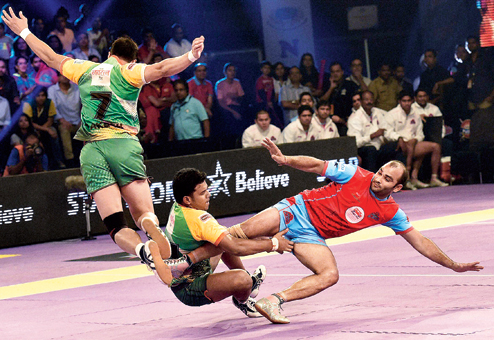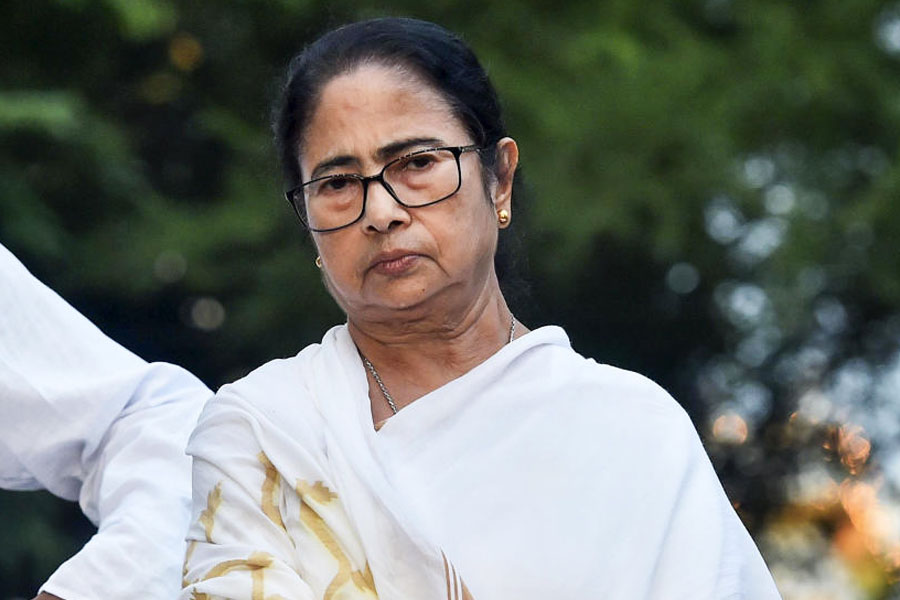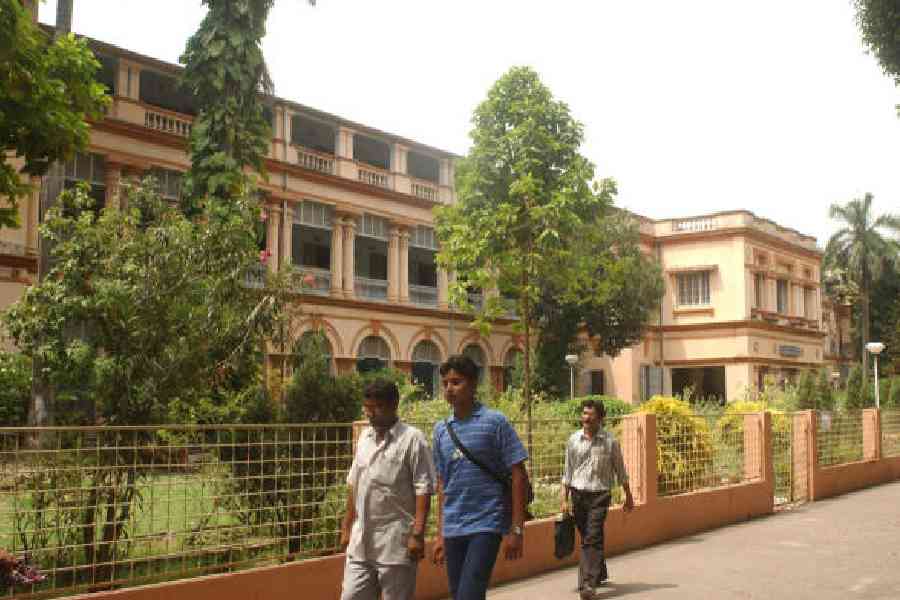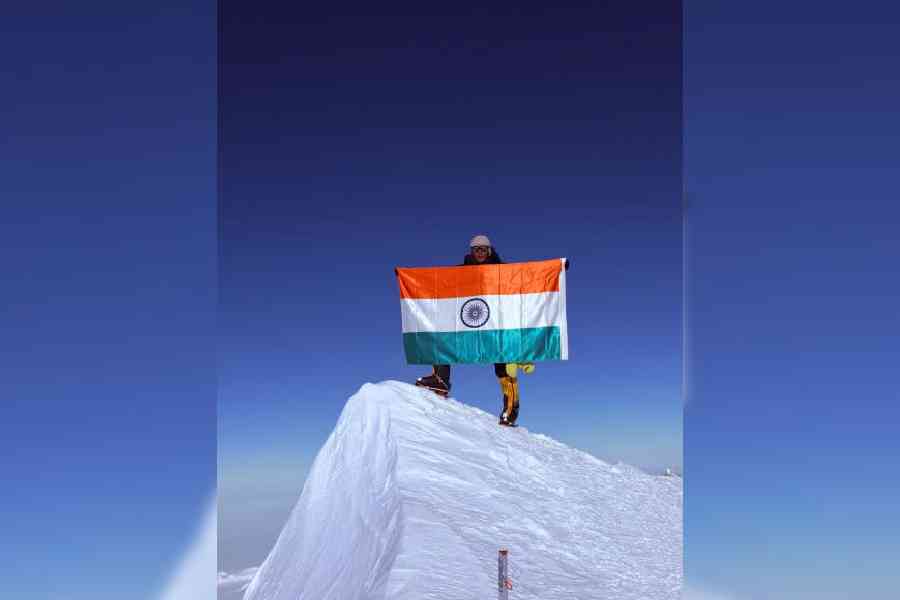-

WEALTH OF SPORTS: Patna Pirates (in green gear) try to hold back a Jaipur Pink Panther player during a recent PKL match.
Sportscaster Charu Sharma's name is synonymous with cricket — or so most people thought. So when he walked into a media conglomerate's office to discuss what has long been seen as a 'rustic sport', Sharma recalls that the executives stopped short of calling him mad. But he wanted to promote kabaddi — and despite the overwhelming lack of interest, persisted.
Then one day he walked into Star India's office in Mumbai. He thought the channel — with its international appeal — wouldn't really be interested in a game of team wrestling. It turned out he was wrong. In July, the Pro Kabbadi League (PKL) — promoted by Sharma, industrialist Anand Mahindra and two others — was telecast on Star Sports.
In India, where cricket is God, other sports are making their presence felt. For the first time, for instance, an international football tournament is being held in the country. Fifa president Sepp Blatter described India as football's 'sleeping giant' while giving it the mandate to host the Under-17 Fifa World Cup in 2017.
Soccer lovers can also look forward to the Hero Indian Super League (ISL), brought by Reliance Industries and an international sports entertainment company called IMG, which will be telecast on a range of Star India's sports, movie and regional channels. Golf has a new platform, too — Scottish golfer Colin Montgomerie visited Delhi earlier this week for the inaugural Hero Cycles Golf Cup, a tournament for junior golfers.
Kabaddi, of course, has been warmly embraced by sports lovers. Around 15,000 people jostled for space at Delhi's Indira Gandhi Indoor stadium for the World Kabaddi League (WKL) in August. The television viewership figures for PKL were not far from those of the Indian Premier League (IPL).
'Give people the sport in a format that they love and they will lap it up,' Sharma says. PKL's success proves his point. The finale was watched by one out of every four television viewers in India. Around 435 million viewers caught the action spread over 36 days, second only to the 552 million viewers for the last season of IPL.
Uday Shankar, chief executive officer (CEO) of Star India, believes that kabaddi has set a new benchmark of viewership for any non-cricketing sport. 'The mushrooming of domestic leagues and the inspiration from international sporting events are set to take sports to a much greater level. The next few years will give birth to a new sporting nation,' Shankar predicts.
That explains why Star Sports last year unveiled plans of investing Rs 20,000 crore in the sports business. It also launched six sports channels, including two high definition (HD) channels.
For long years, India has been seen as one-sport nation. Cricket has always ruled, but the launch of IPL in 2008, based on the model of European football leagues, brought further glitz to the game. The 20-20 format of the game became popular, and sponsors vied with one another to get a piece of the cricket pie.
'But then in the last two to three years an element of fatigue crept in as there was too much of cricket happening throughout the year,' says Thomas Abraham, co-founder of SportzPower, a Mumbai-based provider of sports business news and knowledge.
In an age where the popularity and reach of a game is gauged by TV viewership figures, channels are promoting different sports — and hoping to draw eyeballs.
The organisers of WKL maintain that it was the most watched sport on Sony Six channel after the Fifa World Cup. 'Though we expected a good response from traditional centres such as Punjab and Haryana, we were surprised to find places like Madhya Pradesh and Gujarat showing a great interest in the game,' says WKL CEO Raman Raheja.
Experts believe that the interest in other games started growing after India won cricket's ODI World Cup in 2011 but started performing poorly in subsequent tournaments. Cricket was also mired in spot and match fixing controversies. Earlier still, there were signs that interest in cricket had been waning.
In 2009, the Indian Cricket League (ICL) wound up after two years because of lack of commercial interest. The dipping TVRs (television viewer ratings) for various cricketing tournaments including the IPL led to a cut in advertising rates.
According to a 2012 report by financial services group Edelweiss, advertisers demanded a cut in advertising rates in the fifth season of the IPL in 2012 because of the lower viewership ratings of the previous season. The average TVR for the first week of IPL 7 was 3.1, down from 3.8 in IPL 6 and 3.9 in 2012. The TVR was 4.81 in the launch season in 2008.
Even in team sponsorship money, cricket's share — though still high — is slowly decreasing. Sports business grew from Rs 2,139 crore in 2008 to Rs 4,109 crore in 2013, says the 'India Sports Sponsorship Report 2014' prepared by SportzPower and GroupM ESP, the sports and entertainment arm of GroupM Media. But cricket accounted for 91 per cent of team sponsorship money in 2012, down from 97 per cent in 2009. Other sports, meanwhile, attracted more money. If football drew Rs 10 crore in team sponsorships in 2008, it attracted Rs 44 crore in 2013. For other sports the figures rose from Rs 3 crore to Rs 65 crore during this period.
Much of the money has gone into new leagues for sports, ranging from badminton to boxing (see box on Page 13), sparking interest in games other than cricket. 'As a result a lot of soccer is being played all across the country while golf and tennis have become popular with urban youngsters. Wrestling, boxing and badminton too have their own fan followings,' golfer and Asian Games gold medalist Rishi Narain says.
Narain runs the RN Golf Management Academy, which promotes the Louis Philippe Cup tournament on a franchisee model with 10 city-based teams vying for the Rs 1.2-crore prize money. Golf also got a boost when broadcaster Neo Sport along with sister concern Nimbus Sports signed a three-year contract with the Indian Golf Union in 2011 for the Indian Masters and Indian Open tournaments.
Football is raking in money, too. In ISL, each franchise has paid Rs 15 crore for a year to Reliance-IMG to own the rights to a team. Each team with 14 Indian players, seven international footballers and one marquee player will be worth Rs 40 crore. Sources say that around Rs 100 crore has been set aside for marketing and promotion.
'Besides being a great opportunity to play with international footballers, the League will increase the price of our home players,' says Chuni Goswami, captain of the Indian football team which won a gold medal in the Asian Games of 1962. Reliance and IMG have signed a Rs 700- crore deal with the All India Football Federation (AIFF) for the marketing and commercial rights of all competitions organised by AIFF.
Another game getting a leg up is badminton. The Indian Badminton League (IBL), with its ace international players and the sleek presentation, has been lauded. 'Badminton lacked the glamour, fan craziness and razzmatazz that cricket enjoys in India. But now, with the Badminton Association of India taking initiatives such as the IBL, it is bound to become a favourite sport,' says Abhijit Sarkar, head, corporate communications, Sahara India Pariwar and director of Sahara Adventure Sports Ltd. Sahara is one of the team owners.
The million-dollar IBL, launched last year, is said to be the richest event ever played in the sport.
The major sources of revenue for any sporting event are television broadcasting rights, title sponsors, Internet rights, ground sponsors and gate revenue shares. And since media rights are the biggest source, new niche sports channels have been launched to effectively tap this.
'The sports industry witnessed a gradual shift in terms of audience choice since early 2010. It was also an era that saw the emergence of a niche audience that focused on sports other than cricket,' says Rajesh Sethi, CEO, Ten Sports, which launched Ten Cricket and Ten Action (exclusively for football) in 2010, an HD sports channel in 2011 and Ten Golf in 2012.
Advertisers who have been waiting to invest in non-cricket sports are enthusiastic about the changes. 'Advertisers are responding well and are quite curious to know more about the growth of non-cricket sports such as football, badminton, hockey and kabaddi,' says Vinit Karnik, national director, sports and live events, GroupM ESP India.
For brands, sports present an impactful and passionate platform which helps them connect and engage with consumers. 'Advertising spends on sporting events in India have almost doubled in five years. Brands have been on the lookout for newer platforms to engage with their audiences,' Star's Shankar says.
Companies such as Coca-Cola have tied up with AIFF to host the U15 Coca-Cola Cup which offers opportunities for youngsters to play in a national-level football tournament. 'This tournament is also one of the most important scouting opportunities for AIFF to build talent for the upcoming U17 Fifa World Cup,' says Debabrata Mukherjee, vice-president, marketing and commercial, Coca-Cola India.
-

Big player: Sachin Tendulkar, co-owner, Kerala Blasters of the ISL
And as brands demand a cut in the steep advertising rates of IPL they are keen to channel the money into other sports. 'We were able to charge ad rates which were a good 20-30 per cent higher than those for our previously concluded athletics events for the Asian Games,' Sethi of Ten Sports says. 'Some of our ad slots for a few of our niche properties might very soon see a hike in the ad rates,' he adds.
Broadcasters have even started increasing their budgets for sports other than cricket. Previously, Star India would spend over 90 per cent of its sports budget on cricket. 'Now we have kept 30 per cent of our sports broadcasting budget for sports other than cricket,' says Nitin Kukreja, president, Star Sports.
Not surprisingly, players are excited about the trend. 'We used to go to the Asian Games and win medals but no one recognised us. With PKL, both fame and money have come,' says Rakesh Kumar, the highest bid player of PKL.
Sports management firms are also looking at making celebrities out of non-cricket heroes. 'There are at least five to six sports that we are ready to embrace in a big way. We expect to sign up talented players from kabaddi, shooting, badminton, and hockey soon,' says Bunty Sajdeh, CEO of Cornerstone Sport and Entertainment, a Mumbai-based talent management company that represents cricketers Virat Kohli and Rohit Sharma and tennis champion Sania Mirza.
Prasana Krishnan, the business head at Sony Six, contends that India is finally getting ready for sports other than cricket — though he cautions that it's not going to happen overnight. 'You should not forget that cricket has a 30-year lead over others. Cricket became what it is only after India won the 1983 World Cup. So you have to be patient for other sports to catch up,' Krishnan says.
But not everyone is as optimistic. A 2014 CII-KPMG report on the 'Business of Sports' in India highlights some of the problems plaguing the leagues such as lack of transparency in governance, limited engagement of franchises with the local communities and poor monetisation. 'We have to wait and see how all these events turn out. A lot of money has been pumped into the leagues but we have to see if it gets recovered,' says tennis coach Enrico Piperno.
For the time being, though, there is hope for the arena of other sports. Its long winter looks set to pave the way for a new summer.
THE OOMPH FACTOR
• Builder Mahesh Pawar has a simple explanation for why he needed Punjabi rapper Honey Singh as a co-owner of the World Kabaddi League (WKL) team Yo Yo Tigers when he could easily have been its single owner. 'Anything Honey Singh touches turns to gold. His Facebook page has more likes than that of Narendra Modi. Is there a better of way of reaching out to the youth,' he asks.
• The Noida-based Pawar adds that when celebrities lend their name to a sport, the game gets a bigger profile and attracts more spectators. And clearly for the stars, being attached to a team means greater exposure.
• Stars such as Akshay Kumar and Sonakshi Sinha co-own teams in WKL, as does screen villain Rajat Bedi. In the Pro Kabaddi League (PKL), Abhishek Bachchan owns Jaipur's Pink Panthers which won the inaugural tournament recently. Bachchan has his fingers in another pie — he is the owner of the Chennai franchise Chennians FC of the Indian Super League (ISL), a football tournament that is to begin shortly. Actors John Abraham and Ranbir Kapoor and cricketers Sachin Tendulkar and Sourav Ganguly are also a part of the football league.
• Like Pawar, organisers of sporting events stress that celebrities garner more eyeballs. Charu Sharma, managing director of Mashal Sports, the promoters of PKL, says that it was a conscious decision to have stars in PKL. 'The underlined criterion was that the teams should go to known faces. It was critical for the urban youth to appreciate the respect that owners brought to the league,' Sharma says.
• For several years now, celebrities have emerged as team owners. It started with Shah Rukh Khan, Juhi Chawla, Preity Zinta and Shilpa Shetty who bid for cricket teams in the Indian Premier League (IPL) in 2008. Mithun Chakraborty owned the Royal Bengal Tigers team in the now defunct Indian Cricket League.
• 'Cricket draws celebrities. There is no doubt about that. But if you want to attract people to sports other than cricket, you need the celebs. They will add that oomph factor,' WKL CEO Raman Raheja says.
• But, of course, celebrities alone cannot make a sporting event or a team a success. Take Sanjay Dutt, who launched the Super Fight League, a mixed martial arts fighting sport in 2012. It held a tournament in 2013, but its future is unclear.
• Likewise, India's first motorsports league i1 Super Series was launched with much fanfare a few years ago with Telugu star Nagarjuna, Shah Rukh Khan and Tendulkar vying for franchises. But it is yet to take off.
• 'There has to be an eco-system for a sport to thrive. Ultimately sport is about people. Unless they enjoy what they are seeing, the event will not succeed,' sums up Thomas Abraham of SportzPower, a media platform focused on the business of sports.
CRICKET'S STILL KING
• In 2013, cricket attracted Rs 612 crore in team sponsorship money in India versus football's Rs 65 crore and Rs 44 crore of other sports
• In 2008, cricket attracted Rs 424 crore; football attracted only Rs 3 crore
• In 2013, the value of total endorsements by cricketers was Rs 360 crore versus endorsements of Rs 21.7 crore for other sportspeople
• Commercial spots on television for other sports costs a tenth of what it would cost for a international cricket match featuring India
• Pro Kabaddi League of 2014 had a cumulative viewership of 435 million, and IPL 552 million viewers
Sources: SportzPower, GroupM ESP, KPMG, Star Sports and others











